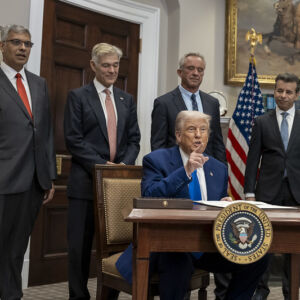President Trump’s executive order on drug pricing and the most-favored-nation strategy has reignited the debate on healthcare reform, promising bold steps toward lowering prescription drug costs. The critical question remains: Will this order lead to genuine change, particularly in the pivotal area of biosimilars — a market with enormous potential for cost savings that has struggled under regulatory complexities, market manipulation and entrenched financial interests?
Although biosimilars promise significant savings, practical obstacles have hindered their widespread adoption. In recent testimony before the House Committee on Ways and Means, the Biosimilars Council emphasized that misguided government policies and manipulative practices by brand-name manufacturers and pharmacy benefit managers have significantly obstructed biosimilar use. For example, pharmacy benefit managers’ formulary decisions often favor higher-priced biologics due to rebate structures that benefit middlemen rather than patients.
A recent IQVIA report highlights this “biosimilar void,” revealing that of 118 biologics set to lose patent protection between 2025 and 2034, only 12 have biosimilars in development. This lack of competition represents nearly $189 billion in potential savings that are lost. Furthermore, complexities in drug pricing and inconsistent regulatory environments have intensified the biosimilar void, discouraging investment and innovation at a time when aggressive action is necessary to improve patient access and affordability.
The Trump order mandates specific actions aimed at accelerating biosimilar approvals and increasing market competition, directly tackling regulatory hurdles and market dynamics that have historically impeded biosimilar development and adoption. As such, the order focuses on two activities: (1) overall approval of biosimilars and other products; and (2) addressing limitations in the Inflation Reduction Act.
A critical directive requires the issuance of a report within 180 days, outlining administrative and legislative recommendations to expedite approvals for generics, biosimilars, and second-in-class medications.
Even as the order directs Health and Human Services to work with Congress to address the “pill penalty,” which imposes price controls on small-molecule drugs earlier than biologics, there are other important changes needed to ensure that the IRA does not block biosimilar development. This includes providing transparency and predictability so that a biosimilar developer can invest in a lower-cost product with certainty that IRA price controls won’t block its adoption.
Recently, the White House issued a second directive establishing “most-favored-nation” pricing for branded drugs and biologics. The order seeks the lowest price paid in other developed countries. While it has caused a stir, most-favored-nation pricing is another novel experiment when there are already alternative strategies proven to drive down costs without triggering adverse market effects.
A vibrant generics and biosimilars marketplace is not hypothetical — it has consistently delivered massive price cuts of 90 percent or more by allowing competition to work. Any comprehensive strategy should focus long-term energy on policies that expand, rather than upend, the proven savings engine of generics and biosimilars.
Ultimately, more is needed to create a thriving and sustainable biosimilars market. To rapidly implement reforms and achieve immediate savings, the administration and Congress should focus on the following:
—Speed biosimilar competition by putting an end to abuse patent thickets.
—Encouraging “biosimilars first” and increasing transparency and accountability for pharmacy benefit managers by mandating clearer disclosure of rebates and administrative fees to foster competitive market conditions.
—Ensure that the IRA price controls do not harm biosimilar competition by refining and extending the biosimilar delay request, ending the unfounded and unclear “bona fide marketing” standard, etc.
—Streamline regulatory requirements by removing redundant clinical efficacy trials and standardizing interchangeability guidelines.
—Encourage global regulatory alignment to lower biosimilar development costs and expedite market entry.
Ensuring swift and effective policy translation of these directives into tangible outcomes is crucial. Federal agencies must promptly operationalize these reforms, as previous experiences suggest bureaucratic delays could hinder necessary progress. Immediate administrative action combined with clear legislative frameworks is essential to capitalize on potential biosimilar savings.
Ultimately, this order represents a significant step toward establishing a sustainable and competitive biosimilar market. Successful implementation of these reforms will not only generate substantial savings for patients and the healthcare system but also encourage further investment and innovation in biosimilar products.
Policymakers must act decisively to ensure these opportunities are realized, transforming potential savings into tangible economic and therapeutic benefits for millions of Americans.


